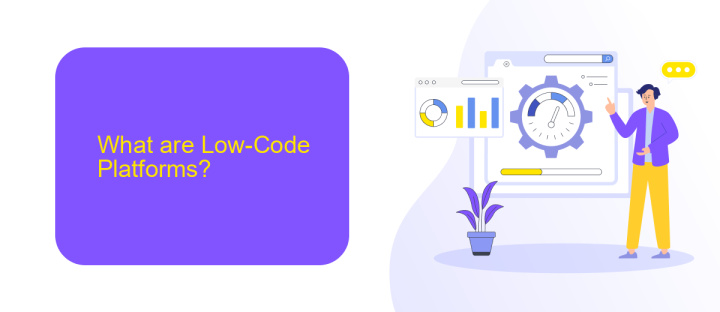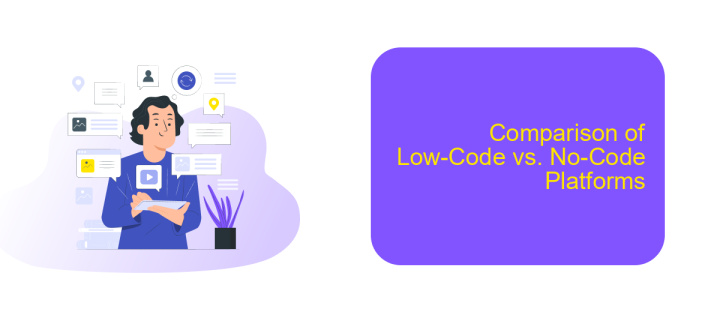Low-Code vs No-Code Platforms
In today's fast-paced digital landscape, businesses are constantly seeking efficient ways to develop software applications. Low-code and no-code platforms have emerged as powerful solutions, enabling rapid development with minimal coding effort. This article explores the key differences between low-code and no-code platforms, helping you understand which approach might be best suited for your organization's needs.
Introduction
In today's rapidly evolving technological landscape, businesses are constantly seeking ways to streamline their operations and enhance productivity. One of the most significant advancements in this realm is the emergence of Low-Code and No-Code platforms. These platforms empower users to create applications with minimal or no coding experience, thus democratizing the development process and accelerating digital transformation.
- Low-Code Platforms: Require some level of coding knowledge, offering a balance between customization and ease of use.
- No-Code Platforms: Designed for non-technical users, enabling them to build applications through intuitive drag-and-drop interfaces.
- Integration Tools: Services like ApiX-Drive facilitate seamless integration between various applications, enhancing the functionality of both Low-Code and No-Code solutions.
By leveraging Low-Code and No-Code platforms, organizations can reduce development time, lower costs, and empower a broader range of employees to contribute to the digital innovation process. As these platforms continue to evolve, they promise to play a crucial role in shaping the future of software development and business operations.
What are Low-Code Platforms?

Low-code platforms are development environments designed to enable the creation of applications with minimal hand-coding. These platforms provide visual interfaces with simple logic and drag-and-drop features, allowing developers to build and modify applications quickly and efficiently. By abstracting and automating much of the underlying code, low-code platforms reduce the complexity of software development, making it accessible to a broader range of users, including those with limited coding experience.
In addition to speeding up the development process, low-code platforms often come with pre-built templates and components, which further simplify the creation of complex applications. They also support integration with various third-party services and APIs, streamlining workflows and enhancing functionality. For instance, ApiX-Drive is a service that facilitates seamless integration between different applications, enabling businesses to automate data transfers and synchronize operations effortlessly. This capability is particularly valuable for organizations looking to enhance their digital transformation initiatives without the need for extensive coding expertise.
What are No-Code Platforms?

No-code platforms are tools that enable users to create applications without writing any code. These platforms are designed for individuals who may not have a technical background but still need to develop software solutions. By providing a user-friendly interface, no-code platforms allow users to drag and drop components, making the development process more accessible and efficient.
- Visual Development: Users can design their applications using visual interfaces.
- Pre-built Templates: Many platforms offer templates to accelerate the development process.
- Integration Capabilities: Tools like ApiX-Drive facilitate seamless integration with other services.
- Scalability: No-code platforms often provide scalable solutions to grow with your business needs.
These platforms are particularly useful for small businesses and startups that need to develop applications quickly without investing heavily in technical resources. Additionally, they empower non-developers to bring their ideas to life, thus democratizing the app development process. With the help of integration services like ApiX-Drive, users can easily connect their applications to various external systems, enhancing functionality and streamlining workflows.
Comparison of Low-Code vs. No-Code Platforms

Low-code and no-code platforms are revolutionizing the way businesses develop software, offering varying levels of customization and technical expertise. Low-code platforms provide a more flexible environment, enabling developers to write some code while leveraging pre-built components. This is ideal for complex applications that require custom integrations and advanced functionality.
No-code platforms, on the other hand, are designed for non-technical users, allowing them to build applications through drag-and-drop interfaces without writing any code. These platforms are perfect for simple applications and quick prototypes but may lack the flexibility needed for more complex projects.
- Customization: Low-code offers higher customization options compared to no-code.
- Ease of Use: No-code is more user-friendly and accessible for non-developers.
- Integration: Low-code platforms often support more advanced integrations, such as those facilitated by ApiX-Drive.
- Development Speed: No-code can accelerate development for simple applications, while low-code balances speed with complexity.
In summary, the choice between low-code and no-code platforms depends on the specific needs of the project and the technical expertise available. Low-code is better suited for complex, customizable applications, while no-code is ideal for rapid development of straightforward solutions.
- Automate the work of an online store or landing
- Empower through integration
- Don't spend money on programmers and integrators
- Save time by automating routine tasks
Conclusion
In conclusion, both low-code and no-code platforms offer significant advantages for businesses aiming to accelerate their digital transformation. Low-code platforms provide a flexible environment for developers to create complex applications with minimal hand-coding, making them ideal for organizations with technical expertise. On the other hand, no-code platforms empower non-technical users to build functional applications quickly and efficiently, democratizing the development process and reducing the dependency on IT departments.
Choosing between low-code and no-code solutions depends on an organization's specific needs and resources. For businesses requiring robust customization and integration capabilities, low-code platforms offer the necessary flexibility. For simpler, more straightforward projects, no-code platforms provide a user-friendly approach. Tools like ApiX-Drive can further enhance these platforms by simplifying the integration of various services, ensuring seamless data flow and operational efficiency. Ultimately, the right choice will align with the company's goals, technical skill set, and desired speed of implementation.
FAQ
What is the difference between Low-Code and No-Code platforms?
Who can benefit from using Low-Code platforms?
Are No-Code platforms suitable for complex applications?
Can Low-Code and No-Code platforms be used together?
How do Low-Code and No-Code platforms handle integrations?
Apix-Drive will help optimize business processes, save you from a lot of routine tasks and unnecessary costs for automation, attracting additional specialists. Try setting up a free test connection with ApiX-Drive and see for yourself. Now you have to think about where to invest the freed time and money!


